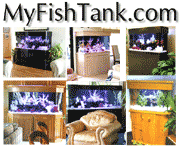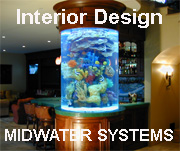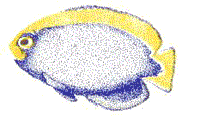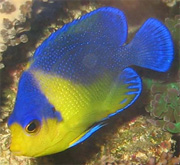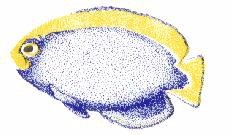|
THE ECHINODERMS,
THE CRINOIDS AND THE OPHIOROIDS
By. Jim Wolf C.S.U.N. Marine Biologist
The 600 plus species of Crinoids (feather stars and sea lilies), and
the 2,000 species of Ophioroids (serpent, brittle and basket stars), are
lumped into this one article not because of their closeness of kin, but
because they share many features, and both are uncommon in aquariums. Both
groups lack or have reduced tube feet and anus, and on a superficial level
share many ecological and morphological features. As with all echinoderms
a slow careful acclimation is necessary to avoid osmotic (salinity) shock.
Now let look at each group more detail.
The Crinoids are the most primitive of the Echinoderms with a history
stretching back over 400 million years. Some primitive groups live attached
permanently to the substrate others can actually swim by beating their
feathery arms. Lamprometra is a common genera. This animal lives in the
Caribbean. Anchored by structures called cirri, it uses its upturned arms
to filter the water for microscopic plankton. They are harmless to other
animals and much care should be taken to see that no large invertebrates
(crabs and shrimps) or predatory fish pick on them. They like a tank with
dark crevices that have a strong water flow. A liquid invert food and live
plankton feed right at dusk will stimulate feeding. Briefly (1-2 hours)
turn off external mechanical filters to insure that they get some food.
They are quite delicate, and should only be placed in well established
invertebrate aquariums that receive regular feedings.
There are three principle types of Ophioroid body plans but before we
discuss their specific biology, lets review some points pertinent to all
ophioroids. They are for the most part small harmless bottom dwellers,
that either filter feed or scavenge.
Serpent Stars are surprisingly mobile and many species will rapidly
hide from the light if exposed (a phenomena call negative photo-taxis).
The first two groups are the serpent and brittle stars. They can be distinguished
from one another by the many small protuberances that are on the surface
of brittle stars. Both have an interesting habit of casting off an arm
if provoked, and will quickly generate a new one.
Brittle stars (i.e. Ophiothrix) are small harmless filter feeders, that
are a common component of well established live rocks. Serpent stars (i.e.
Ophioderma) are larger somewhat more active predators that might even catch
and eat a small slow moving shrimp or fish. Both enjoy a well established
aquarium with plenty of places to hide. The smaller specimens do well on
a diet of liquid food, and the larger enjoy a small chunk of fish or squid
every 1-2 weeks.
The final group of ophioroids are the bizarre basket stars (i.e. Astrophyton).
They resemble a circular mesh of tentacles and share similar demands to
the Crinoids when it comes to a tank. There is nothing quite as bizarre
as watching one of the softball sized lumps unfurl into a two yard wide
mesh of arms as the sun is setting on the reef. The smaller ones occasionally
available through stores are equally spectacular. These two classes of
echinoderms while quite secretive and rare, are well worth a second look.
|
